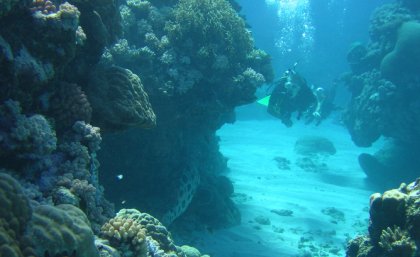
An international scientific team has used a 23-million-year fossil record to calculate which marine animals and ecosystems are most at risk of extinction today.
The research indicates tropical regions are the most threatened, said Professor John Pandolfi, from The University of Queensland and the ARC Centre of Excellence for Coral Reef Studies.
“Marine species are under threat from human impacts, but knowledge of their vulnerabilities is limited,” Professor Pandolfi said.
The research showed the predictors of extinction vulnerability, geographic range size and the type of organism had remained consistent for 23 million years.
The researchers were able to use fossil records to assess the baseline extinction risk for marine animals, including sharks, whales and dolphins, as well as small sedentary organisms such as snails, clams and corals.
Professor Pandolfi said the estimates were used to map natural extinction risk in modern oceans.
“We then compared it with recent human pressures on the ocean, such as fishing and climate change, to identify the areas most at risk,” he said.
“These regions are disproportionately in the tropics, raising the possibility that these ecosystems are particularly vulnerable to future extinctions.”
Assistant Professor Seth Finnegan, from the University of California Berkeley, said the researchers mapped the regions where species with a high intrinsic risk currently were most affected by human impact and climate change.
“Our goal was to diagnose which species are vulnerable in the modern world, using the past as a guide,” he said.
“We believe the past can inform the way we plan our conservation efforts. However there is a lot more work that needs to be done to understand the causes underlying these patterns and their policy implications.”
The scientists said identifying the regions and species at greatest risk means conservation efforts can be better targeted.
Dr Sean Anderson, from Simon Fraser University in British Columbia, Canada, said it was difficult to detect extinctions in oceans.
“But fossils can help fill the gaps,” he said.
“Our findings can help prioritise areas and species that might be at greater risk of extinction and that might require extra attention, conservation or management – protecting vulnerable species in vulnerable places.”
The research is published in the paper Paleontological baselines for evaluating extinction risk in the modern oceans, in the journal Science, and can be accessed at http://www.eurekalert.org/jrnls/sci/.
Media: John Pandolfi, +61 (0) 400 982 301, j.pandolfi@uq.edu.au; Eleanor Gregory (communications), +61 (0) 428 785 895, eleanor.gregory@jcu.edu.au.
.jpg)









